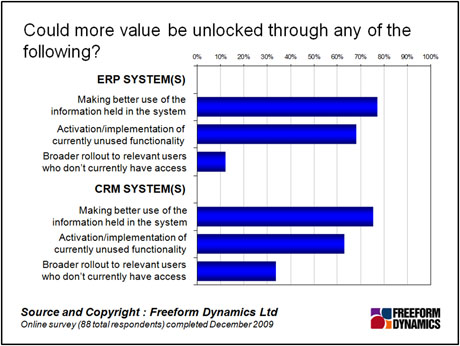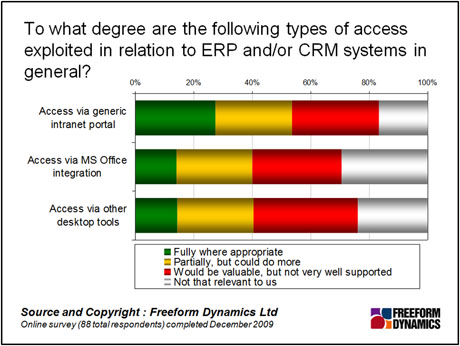With all of that money, time and effort expended on ERP and CRM systems over the years, you would expect organisations to have paid a lot of attention to getting the most from them, but a recent poll (including 66 ERP users and 65 CRM users) suggests that many implementations have some way to go before they deliver their full potential (Figure 1).

Figure 1
To be fair, when looking at this picture we must acknowledge that putting such systems in place and getting them properly bedded into the business is not a trivial exercise, and as one reader explained:
“We have only just implemented ERP – people are still learning the system. It may take several years to fully realise the benefits.”
Indeed some would argue that ERP and CRM implementation is a perpetual process and that with ever evolving business requirements, it is unrealistic to expect systems to ever be ‘finished’. Nevertheless, the above does suggest the presence of a lot of unrealised potential, particularly in association with CRM. And the following reader comment provides some insight into why such big gaps often exist, even with more established deployments:
“The day-to-day use of ERP and CRM is ingrained with the users. Most do not see the benefits to be had by using the systems in a smarter way. The tools only get used to ’do the job’ not to do the job well.”
This goes back to our previous discussion about systems often being implemented originally to deal with particular process-oriented requirements, then the capability delivered not being revisited thereafter, which, as another reader said, highlights the imperative to:
“Remind senior management that these systems are not fire and forget.”
Good advice, perhaps, but where exactly should you be looking to unlock additional value from ERP and CRM systems? Well, switching on previously inactive functionality that was not within the original implementation scope is mentioned by two thirds of our poll respondents, but top of the list, highlighted by an even greater number, is enabling better use of the information stored in systems of this kind (Figure 2).

Figure 2
The truth is that ERP and CRM applications can accumulate large amounts of transaction data that potentially represents a significant business asset, but is often simply too hard to get at and make sense of. As a result, the practice of users with little formal IT knowledge or discipline extracting information into Excel spreadsheets and other offline tools will be familiar to most users reading this, as will the associated dangers and costs. The sentiment articulated by this reader is therefore likely to strike a chord with many:
“The greatest benefit from ERP/CRM is only to be obtained when [dependency on] office software is dropped so the ERP system is actually the centre of information.”
But in the absence of more elegant and controlled mechanisms in the majority of situations, many users would argue that they have no choice. The level of integration with desktop tools is typically partial at best, with many alluding to poor or non-existent capability (Figure 3).

Figure 3
The shame about the picture we are building up is that one of the areas in which application vendors have invested heavily in recent times is business intelligence (BI). It is becoming increasingly more common for mainstream ERP and CRM suppliers to offer BI and analytics options and extensions, typically with plug-ins for easy access from Microsoft Office and various techniques to achieve full integration with other desktop tools and portal environments.
Considering the question of access more broadly, one of the things we haven’t yet mentioned from the earlier chart we were looking at (Figure 2) is that over a third of those with CRM applications in place see a value in embracing groups of users that are not currently on the system. The proportion is smaller with ERP (14 per cent), probably due to the ‘back office’ nature of such solutions, but we suspect that both numbers would be significantly higher if more flexible access mechanisms were considered such as those we have been discussing in the context of BI, but for more general activity. Indeed, comments like the following that relate to more ‘occasional’ users reinforce this notion:
“Developing portal access to ERP functionality allows for faster and/or better information transfers (requests for absence, yearly evaluation, competences management…)”
But whether it’s new or existing users, the one thing for certain is that many organisations see the value of enabling a range of alternative ERP and/or CRM access options to support more flexible working patterns in general (Figure 4).

Figure 4
So, if you take a step back, the chances are that if you put the original system scope and objectives to one side, and review your current requirements in a more open-minded manner alongside the capability that is today on offer from the vendor community, you’ll probably be able to identify a number of areas in which more value can be unlocked from your existing application package investments. And in many cases, a significant amount of additional value can often be tapped into with a relatively modest level of incremental investment.
Through our research and insights, we help bridge the gap between technology buyers and sellers.